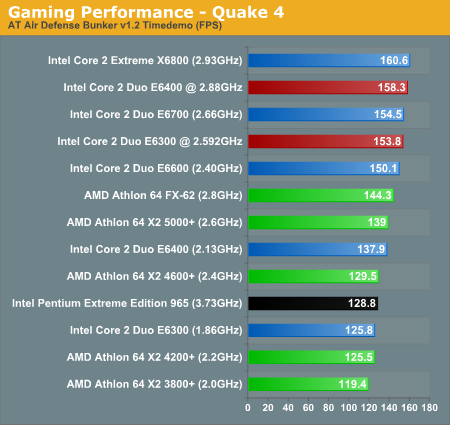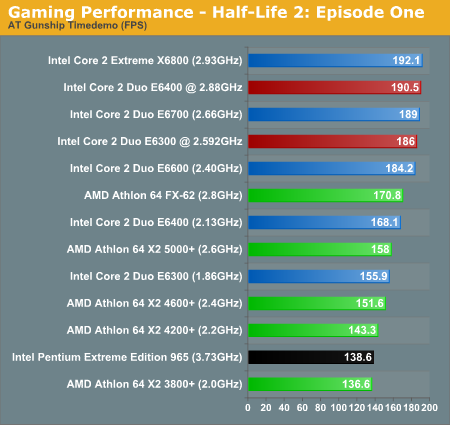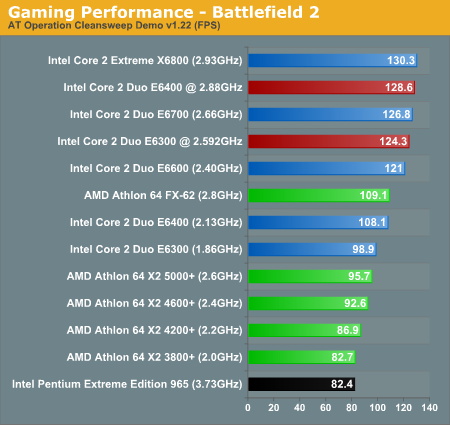Intel Core 2 Duo E6300 & E6400: Tremendous Value Through Overclocking
by Anand Lal Shimpi on July 26, 2006 8:17 AM EST- Posted in
- CPUs
Gaming Performance using Quake 4, Battlefield 2 & Half-Life 2 Episode 1
Our gaming performance analysis starts out with Quake 4 running at 1600 x 1200 with High Quality visual settings. We used version 1.2 of Quake 4 and SMP was enabled:

Once we shift over to gaming performance, the differences between all of the tested systems are greatly diminished. Enabling 4xAA would further reduce the difference, to the point where most of the systems would be about equal. This does not change the fact that the Core 2 Duo chips are able to outperform their AMD counterparts in terms of raw performance, so once faster graphics cards become available we should see the processors begin to differentiate themselves more. Of course, by then we might also have games that are more demanding of the GPU.
Looking specifically at Quake 4 performance -- and remember that this is one of the few games that can truly take advantage of multiple processor cores -- the Core 2 processors continue to outperform their AMD counterparts, but only by a small margin. The overall spread between the X6800 and the X2 3800+ is 35%, which is certainly noticeable, but with frame rates that are all averaging over ~120 FPS Quake 4 is clearly going to run well on all of the tested systems. We had hoped to include Prey performance as well, so that we could see how an updated Quake 4/Doom 3 engine game performs, but we ran into benchmarking issues that we are currently investigating.
Next up we've got the recently released Half Life 2: Episode 1, running at default quality settings (auto detected with a pair of X1900 XTs installed) with the exception of AA and aniso being disabled. As with all of our gaming tests in this article we tested at 1600 x 1200:

In Half-Life 2: Episode One, the Performance spread is 41%. At the top end of the spectrum, we're beginning to become GPU limited even without antialiasing enabled. Valve's Source engine clearly likes the Core 2 architecture, as even without overclocking the E6300 and E6400 clearly perform better than their similarly priced AMD counterparts.

Battlefield 2 is a game that has consistently demonstrated it is more CPU limited than GPU limited, especially with high-end graphics solutions. Here the spread between the processors is 58%, and the E6300/E6400 without overclocking are faster than everything from AMD except for the FX-62. At the top end of the spectrum, we finally begin to reach the limitations of our GPUs, with the top four systems all performing within 3% of each other.










137 Comments
View All Comments
drebo - Thursday, July 27, 2006 - link
That's exactly my freaking point.These prices, while listed on their respective manufacturers sites, are not correct. They are two different pricing schemes. One is using the price at which Intel sells them to distributors, the other is not using any pricing scheme that I've ever seen before, except on this site.
I have varifiable proof(read: I know for an ABSOLUTE FACT) that the AMD prices are too high. How do I know this? Because my distributor prices are lower than what is listed in this article. Ergo, the prices listed CANNOT be the prices at which AMD sells to distributors.
Thus, you're using two different pricing scales, making any conclusions based on pricing completely bogus.
Here are accurate pricings(I'll list my price as well as listed MANUFACTURER Suggested Retail Price):
Athlon64 X2 3800+ - $149.00 - MSRP: $186.25
Athlon64 X2 4200+ - 183.00 - 228.75
Athlon64 X2 4600+ - 235.00 - 293.75
Athlon64 X2 5000+ - 294.74 - 368.75
Athlon64 FX-60/62 - 811.00 - 973.95
Core 2 Duo E6300 - 199.58 - 229.95
Core 2 Duo E6300 BTX - 209.05 - 229.95
Core 2 Duo E6400 - 239.58 - 272.95
Core 2 Duo E6600 - 334.32 - 379.95
Core 2 Duo E6700 - 553.26 - 629.95
Core 2 Duo X6800 - 1021.68 - 1164.95
Now, regardless of which pricing you use(distributor pricing, which is based off of manufacturer pricing, or MSRP), the pairings in the article are ALL incorrect. I tell everyone who asks to take these kinds of articles with a grain of salt.
coldpower27 - Thursday, July 27, 2006 - link
That's not good enough, your word isn't a verifiable item. So that is what needs to be taken with a grain of salt.
It's has to be publicly available information on the web avialable from AMD and Intel, which it is as the AMD pricing charts are avaialble at AMD's site. The Intel numbers correlate directly to Intels' 1000 Unit Quantity chart.
The pricing chart listed for you is only worthwhile for you.
As well the current pricing scheme you posted correlates quite well to which processor vs which processor.
I am using the pricing scales using available information, the pricing scales you have been using aren't publically available so they can't be used. The results used in this article are jsut fine.
The problem with the information you posted is this is the first time I have seen numbers like that and it wasn't available to all.
The MSRP's you quoted while higher then the ones listed in the article paint approximately the same picture.
4200+ vs E6300
4600+ vs E6400
5000+ vs E6600
Your prices will not be use, as they are different from everything else we have seen so far.
The numbers in the article are apples to apples as they are both what is available to the public by both corporations.
drebo - Thursday, July 27, 2006 - link
That is EXACTLY what I said. Do you even read things before you reply to them?
The Intel pricing is using Intel's price to distributors. The AMD pricing is not using any pricing that is available in any chart or anywhere else.
Hence: the Intel pricing is too low and the AMD pricing is too high...thus forcing processor comparisons that do not actually exist.
And, no, my pricing is not only available to me. It's available to any company that uses distributors, because the pricing is the same, within a few dollars, between all of my distributors. Regionally, every company generally uses the same distributors. Thus, the pricing available from distributors is extremely relevant, despite the fact that you would like it to be otherwise.
wilki24 - Thursday, July 27, 2006 - link
Erm... pulling the two (closest) price points out from ZZF:A64 X2 4600+
Anand: $240
ZZF: $260
Delta = $20
E6400
Anand: $224
ZZF: $239
Delta = $15
*****
A64 X2 3800+ (Really should be the 4200+, since it's closer to the E6300 in price, but ZZF has majorly overinflated prices for that chip for some reason.)
Anand: $152
ZZF: $154
Delta = $2
E6300
Anand: $183
ZZF: $199
Delta = $16
In one case, the delta between the two is $5 in Intel's favor, and in the other (not quite matched up price point) it's $14 in AMD's.
Going by ZZF, it would seem that the point you're trying to make doesn't seem to be based in fact.
coldpower27 - Wednesday, July 26, 2006 - link
The prices are completely accurate as they are MSRP's. You want "real world" pricing, this fluctuates based on supply and demand, and is pointless to report as it constantly changes.If AMD wanted they could have listed their "OEM Distributer" pricing on their website, but they don't so we go by what they have listed there. If you want, you can complain to AMD about not listing the distributer pricing on their site.
coldpower27 - Wednesday, July 26, 2006 - link
Like I said if your talking about prices at online retailers it will be a different story, I already discussed this part. Those reamin to be seen.bob661 - Wednesday, July 26, 2006 - link
The AMD prices are a tad higher than listed at ZZF and Monarch. We'll have no way of knowing Intel pricing until the chips are released. I heard it got pushed back to 8/7.coldpower27 - Wednesday, July 26, 2006 - link
Yeah judging by what we have seen so far, no online store has decreased below AMD's retail pricing on their website for the time being. Let alone the OEM distributer prices reported by Dailytech earlier before.gmallen - Wednesday, July 26, 2006 - link
For AMD owners, the true cost of using Conroe includes a new motherboard. I can upgrade to the 5000+ with my current board. So, for me, the AMD solution is much cheaper.krisia2006 - Wednesday, July 26, 2006 - link
The AM2 AMD cpus in the review also require a new mobo/platform for many AMD owners, no?